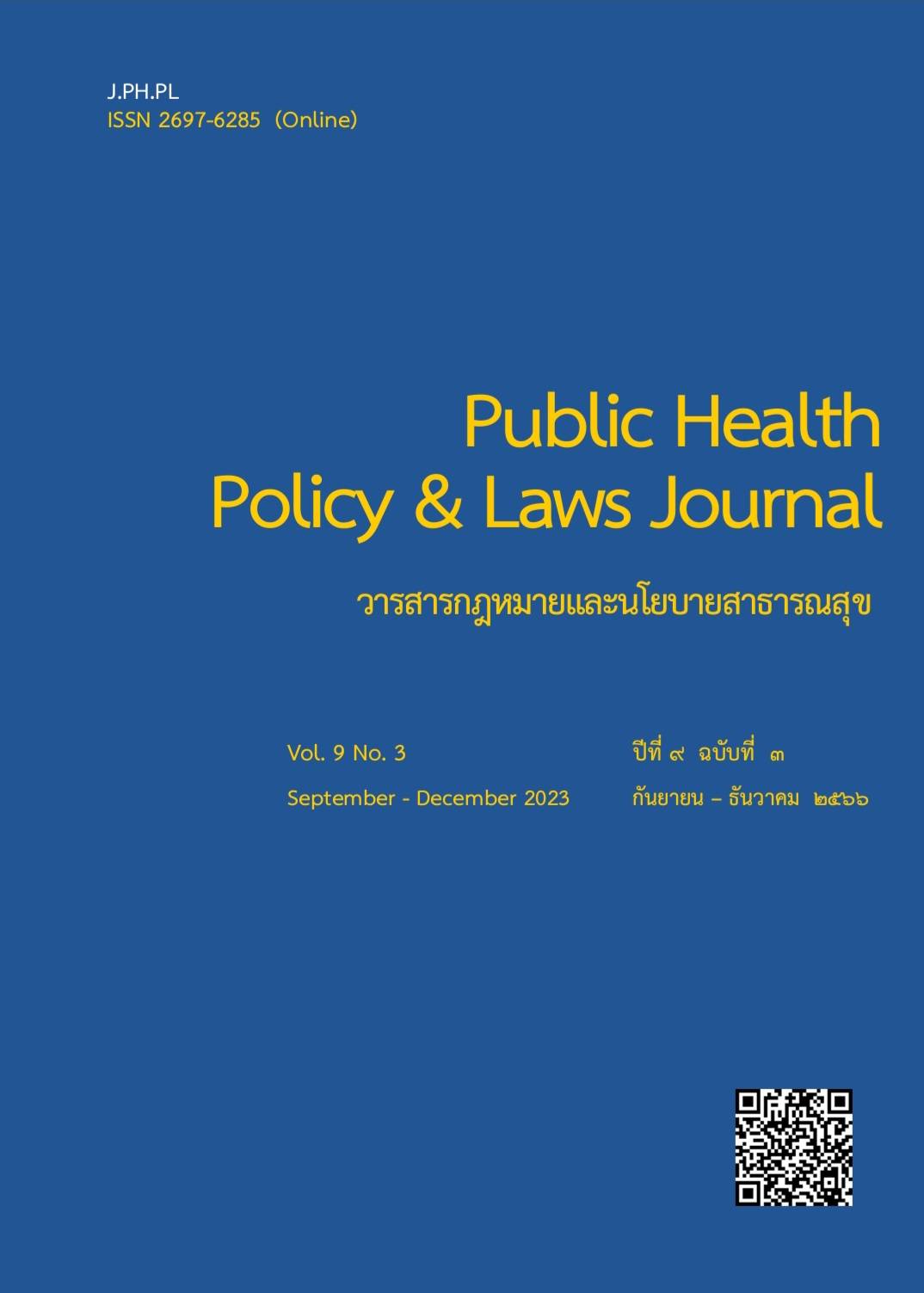การประเมินผลโครงการเอ็นซีดีแอดโฮมเพื่อการรักษาและดูแลผู้ป่วยโรคเบาหวานและความดันโลหิตสูง ในอำเภอวัฒนานคร จังหวัดสระแก้ว
คำสำคัญ:
เบาหวาน, ความดันโลหิตสูง, แอปพลิเคชัน, เอ็นซีดีแอดโฮม, โมเดลตรรกะบทคัดย่อ
การประเมินผลโครงการเอ็นซีดีแอดโฮมเพื่อการรักษาและดูแลผู้ป่วยโรคเบาหวานและความดันโลหิตสูง อำเภอวัฒนานคร จังหวัดสระแก้ว โดยประยุกต์ใช้โมเดลตรรกะ กลุ่มตัวอย่างเป็นผู้ปฏิบัติงานหลักในโครงการ รวม 26 คน ประกอบด้วยแพทย์ เภสัชกร พยาบาล เจ้าหน้าที่ผู้ดูแลระบบสารสนเทศ และอาสาสมัครสาธารณสุขประจำหมู่บ้าน (อสม.) เก็บรวบรวมข้อมูลด้วยการสัมภาษณ์แบบเจาะลึกและการสนทนากลุ่มโดยใช้แนวคำถาม และรวบรวมข้อมูลทุติยภูมิจากเอกสารและระบบบริการโดยใช้แบบบันทึก วิเคราะห์ข้อมูลเชิงคุณภาพด้วยการวิเคราะห์เนื้อหาและวิเคราะห์ข้อมูลปริมาณด้วยจำนวนและร้อยละ
ผลการศึกษาพบว่าหลังเข้าร่วมโครงการผู้ป่วยโรคเบาหวานมีระดับ HbA1c อยู่ในเกณฑ์ควบคุมได้ร้อยละ 83.9 ซึ่งต่ำกว่าก่อนเข้าร่วมโครงการ (ร้อยละ 96.4) ในขณะที่ผู้ป่วยโรคความดันโลหิตสูงมีระดับความ ดันโลหิตอยู่ในเกณฑ์ควบคุมได้ใกล้เคียงกัน (ร้อยละ 98.3 และ 100.0 ตามลำดับ) ผู้ป่วยที่เคยเข้ารักษาเป็นผู้ป่วยในของโรงพยาบาลช่วง 2 ปีก่อนเข้าร่วมโครงการ จำนวน 37 คน ไม่มีการกลับมารักษาซ้ำในแผนกผู้ป่วยในภายในระยะเวลา 1 ปีหลังเข้าร่วมโครงการ ความแออัดหรือจำนวนครั้งเข้ารับบริการของผู้ป่วยทั้งสองโรคมีแนวโน้มลดลงเล็กน้อย ส่วนการขาดนัดลดลงในช่วงแรกและเพิ่มขึ้นในช่วงหลัง หลักสูตรการอบรมมีความเหมาะสมแต่ขาดการอบรมฟื้นฟูที่ต่อเนื่อง เกณฑ์การวินิจฉัยและคัดเลือกที่มีความเข้มงวดสามารถลดผลกระทบในผู้ป่วยได้ แต่ทำให้ มีการคัดเลือกผู้ป่วยเข้าร่วมโครงการน้อย การใช้แอปพลิเคชันในการเยี่ยมบ้าน กำกับติดตาม และประเมินสุขภาพผู้ป่วยลดลง และภาระงานในช่วงการระบาดของโรคติดเชื้อไวรัสโคโรนา 2019 ทำให้มีการปรับเปลี่ยนกระบวนการเยี่ยมบ้านและส่งยาถึงบ้าน มีความจำกัดในงบประมาณสำหรับการพัฒนาบุคลากร อุปกรณ์ และเครื่องมือในบริการเยี่ยมบ้าน ระบบเทคโนโลยีสารสนเทศเหมาะสมแต่มีความซ้ำซ้อนในการบันทึกข้อมูลกับระบบเดิม ดังนั้นควรกำหนดผู้รับผิดชอบโครงการที่ชัดเจน กำกับติดตามการปฏิบัติงานโดยเครือข่ายบริการสุขภาพ และพัฒนาระบบข้อมูลให้สามารถเชื่อมต่อกับฐานข้อมูลและโปรแกรมเดิม รวมทั้งพัฒนาศักยภาพและสนับสนุนการปฏิบัติงาน อสม. อย่างต่อเนื่อง
เอกสารอ้างอิง
Assawapatchara, N. (2019). Integrated diabetes service system development at Ranong hospital, Ranong province. Journal of Preventive Medicine Association of Thailand, 9(3), 263-279. (In Thai)
Chanchai, K., Therawiwat, M., & Vatanasomboon, P., et al. (2021). The effects of self-efficacy enhancement with social support on medication adherence of hypertensive patients. Thai Journal of Health Education, 44(1), 87-101. (In Thai)
Chiranakhon, Y., Tansawai, V., & Buayom, P. et at. (2013). Evaluation on the implementation of health promotion and prevention program on noncommunicable diseases in the southernmost Thailand, 2013. Disease Control Journal, 39(4), 345-355. (In Thai)
Damrongphong, W. (2022). Factors associated with self-care behaviors of type 2 diabetes patients at Sai Ngam Hospital, Kamphaeng Phet Province. Journal of Disease and Health Risk DPC.3, 16(2), 51-63. (In Thai)
Department of Disease Control, Ministry of Public Health. (2018). Implementation situation for the control and prevention of non-communicable diseases (NCDs). Nonthaburi: Division of Non-Communicable Diseases. (In Thai)
Department of Medical Services, Ministry of Public Health. (2020). Guidelines to reduce overcrowding in hospitals to reduce the spread of COVID-19. Nonthaburi: Division of Medical Technical and Academic Affairs. (In Thai)
Eakpalakorn, W. editor. (2016). Thai national health examination survey (NHES) V 2014. Bangkok, Graphic and design publishing house. (In Thai)
Eakpalakorn, W. editor. (2021). Thai national health examination survey (NHES) VI 2019 – 2020. Bangkok, Graphic and design publishing house. (In Thai)
International Diabetes Federation. (2021). IDF diabetes atlas: diabetes around the world in 2021. Retrieved February 18, 2022, from https://diabetesatlas.org/.
Kanchanapibulwong. A., Khamwangsanga P., & Kaewtha, S. editor. (2020). NCDs situation report (diabetes, hypertension, and related factors) 2019. Retrieved February 18, 2022, from http://www.thaincd.com/2016/media-detail.php?id=13865&tid=&gid=1-015-005. (In Thai)
Khemshutgu, W., & Nugutsava, P. (2011). The devetopment of participatory Primary Care UnitNetwork for decrease congestion of Buriram Hospital. Medical Journal of Srisaket Surin Buriram Hospitals, 26(2), 319-329. (In Thai)
Lertwiriyanan, R. (2013). The relevant factors for controlling blood sugar of diabetes mellitus and hypertension patients in Mae Phag sub-district, Sansai district, Chiang Mai province. Lanna Public Health Journal, 9(3), 216-239. (In Thai)
Ministry of Public Health. (2020). Illness with major non-communicable diseases. Retrieved February 18, 2021, from https://hdcservice.moph.go.th/hdc/reports/page.php?cat_id=6a1fdf282fd28180eed7d1cfe0155e11. (In Thai)
Nakhornriab, S., Wattanakitkrileart, D., & Charoenkitkarn, V. et.al. (2017). The effectiveness of mobile application on medication adherence in patients with stroke. Journal of Nursing Science, 35(3), 58-69. (In Thai)
Puengsawad, S., Kongprom, S., & Pongsetpisan, T. et al. (2018). Development of an information system for patient tracking in the interprofessional education project. Hauchiew Chalermprakiet Science and Technology Journal, 4(2), 7-19. (In Thai)
Sadtrakulwatana, V. (2018). The development of a chronic diseases clinic model (diabetes, hypertension) in primary health care units, Mueang district, Sing Buri province. Journal of Preventive Medicine Association of Thailand, 8(1), 24-36. (In Thai)
Stephani, V., Opoku, D., & Quentin. W. (2016). A systematic review of randomized controlled trials of mHealth interventions against non-communicable diseases in developing countries. BMC Public Health, 16:572, 1-10. Doi: 10.1186/s12889-016-3226-3. PMID: 27417513; PMCID: PMC4946127.
Thailand International Health Policy Program (IHPP). (2017). The Burden of Disease and Injury Report of the Thai Population 2014. Nonthaburi: The Graphic Systems Co., Ltd. (In Thai)
Watthana Nakhon Hospital. (2019). NCD@Home Project: Doctor Wattana's medicine was delivered to the house. Sa Kaeo: Watthana Nakhon Hospital. (In Thai)
W.K. Kellogg Foundation. (2004). Logic model development guide. Retrieved February 18, 2021, from chrome-extension://efaidnbmnnnibpcajpcglclefindmkaj/https://www.betterevaluation.org/sites/default/files/2021-11/Kellogg_Foundation_Logic_Model_Guide.pdf.
World Health Organization. (2021). Fact sheets: hypertension. Retrieved February 18, 2021, from https://www.who.int/news-room/fact-sheets/detail/hypertension.
ดาวน์โหลด
เผยแพร่แล้ว
เวอร์ชัน
- 2024-03-19 (2)
- 2023-09-16 (1)
รูปแบบการอ้างอิง
ฉบับ
ประเภทบทความ
สัญญาอนุญาต
Disclaimer and Copyright Notice
เนื้อหาและข้อมูลในบทความที่ลงตีพิมพ์ในวารสารกฎหมายและนโยบายสาธารณสุข ถือเป็นข้อคิดเห็นและความรับผิดชอบของผู้เขียนบทความโดยตรงซึ่งกองบรรณาธิการวารสาร ไม่จำเป็นต้องเห็นด้วย หรือร่วมรับผิดชอบใด ๆ
บทความ ข้อมูล เนื้อหา รูปภาพ ฯลฯ ที่ได้รับการตีพิมพ์ในวารสารกฎหมายและนโยบายสาธารณสุข ถือเป็นลิขสิทธิ์ของวารสารฯ หากบุคคลหรือหน่วยงานใดต้องการนำทั้งหมดหรือส่วนหนึ่งส่วนใดไปเผยแพร่ต่อหรือเพื่อกระทำการใด ๆ จะต้องอ้างอิงเสมอ




